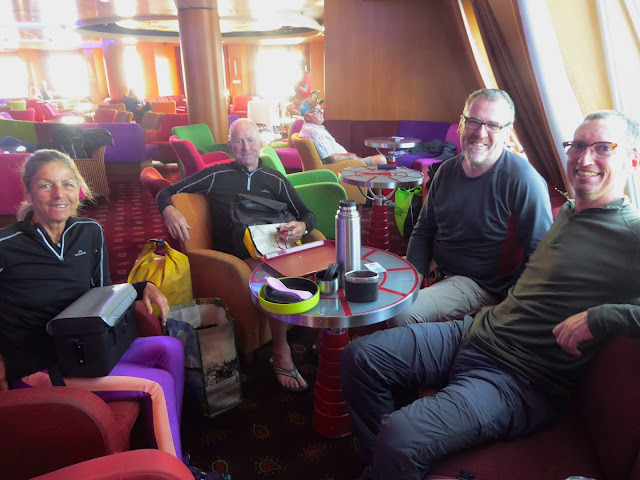"Excuse me, are you thinking of camping there?"
That woman in the high-viz tabard has come back. I knew it'd be a problem. She has already walked past once. It's typical. We're on a little short-cut back road, hardly any houses at all, and we spot a clearing with just a chain across the opening. It looks like an ideal spot to camp after another hot day. Gayle and I are wandering back and forth looking for a decent pitch but without any luck. It's rocky and stony ground. And now here's this woman again - she must be a council worker in that get up.
"Only, if you want, we have a lovely spot by the river you can camp on. It's much nicer than here and it's not that far away."
Jillian is on her evening after-work road walk and tells us that she once saw another cycle tourist camped in a lousy spot on this stretch of road, but as he was already set up for the evening she didn't feel like disturbing him. We, on the other hand, are all too eager to accept her generous offer. She describes her house and phones the kids so that they are not surprised when we turn up. It is as she describes - a lovely spot down by the riverside. When her husband comes home from work he says hello and invites us up to the house for a drink and we spend the evening in their garden by the fire, chatting about all sorts of things.
 The day had begun well. We enjoyed riding the bike trail to Lunenburg, taking us through a series of pretty bays along the way. The houses looked like those of wealthy owners - unsurprising as there's a fast highway to Halifax from here. Lunenburg itself is a pleasant little town kept busy with a steady stream of tourists. We spent a large part of the day looking around, before heading off to camp along the coast. And that was when we meet Jillian, who saves us from a rocky bed.
The day had begun well. We enjoyed riding the bike trail to Lunenburg, taking us through a series of pretty bays along the way. The houses looked like those of wealthy owners - unsurprising as there's a fast highway to Halifax from here. Lunenburg itself is a pleasant little town kept busy with a steady stream of tourists. We spent a large part of the day looking around, before heading off to camp along the coast. And that was when we meet Jillian, who saves us from a rocky bed.
In the morning she leaves the house open for us so that we can use the bathroom before moving on. We are also supplied with fresh eggs from their henhouse. Jillian has told us about the cafe over the river. From her side we take a chain ferry (free to cyclists) to the southern side. And there we find LaHave Bakery - a wonderful place in an old Outfitter's Store. We feel obliged to stop for a mid-morning tea despite only cycling about 800 metres. The sun is shining and it's another beautiful day - summer just won't go away in a hurry.
That woman in the high-viz tabard has come back. I knew it'd be a problem. She has already walked past once. It's typical. We're on a little short-cut back road, hardly any houses at all, and we spot a clearing with just a chain across the opening. It looks like an ideal spot to camp after another hot day. Gayle and I are wandering back and forth looking for a decent pitch but without any luck. It's rocky and stony ground. And now here's this woman again - she must be a council worker in that get up.
"Only, if you want, we have a lovely spot by the river you can camp on. It's much nicer than here and it's not that far away."
 |
| RJ and Jillian |
 |
| what a spot |
 The day had begun well. We enjoyed riding the bike trail to Lunenburg, taking us through a series of pretty bays along the way. The houses looked like those of wealthy owners - unsurprising as there's a fast highway to Halifax from here. Lunenburg itself is a pleasant little town kept busy with a steady stream of tourists. We spent a large part of the day looking around, before heading off to camp along the coast. And that was when we meet Jillian, who saves us from a rocky bed.
The day had begun well. We enjoyed riding the bike trail to Lunenburg, taking us through a series of pretty bays along the way. The houses looked like those of wealthy owners - unsurprising as there's a fast highway to Halifax from here. Lunenburg itself is a pleasant little town kept busy with a steady stream of tourists. We spent a large part of the day looking around, before heading off to camp along the coast. And that was when we meet Jillian, who saves us from a rocky bed. |
| Lunenburg |
 |
| how did we resist the fresh cakes?? |













































